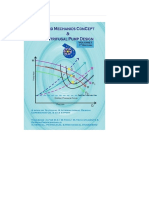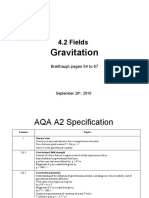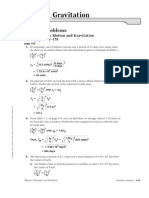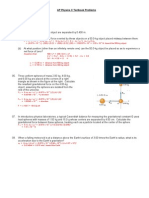L22 Gravitational Field Strength
L22 Gravitational Field Strength
Uploaded by
吴文权Copyright:
Available Formats
L22 Gravitational Field Strength
L22 Gravitational Field Strength
Uploaded by
吴文权Copyright
Available Formats
Share this document
Did you find this document useful?
Is this content inappropriate?
Copyright:
Available Formats
L22 Gravitational Field Strength
L22 Gravitational Field Strength
Uploaded by
吴文权Copyright:
Available Formats
Physics 20 Lesson 22 Gravitational Field Strength
Refer to Pearson pages 216 to 229 for a discussion of gravitational field strength.
I. Gravitational field strength (acceleration due to gravity)
Near the surface of the Earth all objects, regardless of size or shape, are subject to an
2
average acceleration due to gravity of 9.81 m/s acting downward toward the center of
the Earth. Another name for this acceleration is gravitational field strength. As you
move away from the center of the Earth, the gravitational field strength decreases in
magnitude, but its direction remains unchanged. The gravitational field strength is
different for different planets and moons.
When we calculate the gravitational force of attraction between an object and the Earth,
we could use the Universal Law of Gravitation equation
m1m 2
Fg G
r2
or we could use the more familiar
Fg mg mag
When we make these equations equal to one another, we get:
Fg Fg
m1m2
mag G (recognizing that m = m2 )
r2
mm
m2a g G 1 2 2 (m2 cancels)
r
m
ag G 21 (where r is the radius and m1 is the mass of the planet)
r
The gravitational field strength or the acceleration due to gravity for a planet or moon is
calculated using this formula.
Example 1
What is the gravitational field strength on the surface of Neptune?
From the table at the end of this lesson we find the mass and radius of Neptune.
m
ag G 21
r
2 (1.03 10
26
kg)
ag 6.67 10 11 Nm
(2.48 10 m)2
2 7
kg
ag = 11.17 N/kg or 11.17 m/s2
Dr. Ron Licht 22 - 1 www.structuredindependentlearning.com
Example 2
What is the gravitational field strength at a distance of 1.914 x 107 m above the surface
of the Earth? If a person weighs 400 N on the surface, what would he weigh at this
distance?
From the data table on the formula sheet we find the mass and radius of Earth.
r = rE + altitude = 6.37 x 106 m + 1.914 x 107 m = 2.551 x 107 m
m1
ag G
r2
(5.98 1024 kg)
ag 6.67 1011 Nm
2
kg2
(2.551 107 m)2
ag = 0.613 N/kg
The person’s mass can be calculated using Fg = m ag (ag = 9.81 N/kg on the surface)
Fg
m
ag
400N
m N
m = Fg/g = 400 N/(9.81 m/s2 ) = 40.77 kg
9.81 kg
m 40.77kg
The person’s new weight can be calculated using:
Fg mag
Fg 40.77kg(0.613 kg
N
)
Fg = 25 N at 1.914 x 107 m above the Earth
Dr. Ron Licht 22 - 2 www.structuredindependentlearning.com
II. Gravitational force ≠ gravitational field strength
Some confusion may exist between the concepts of gravitational field strength and
gravitational force. Consider three objects like those depicted below. Each object
experiences the same gravitational field strength of –9.81 m/s , assuming that we are
2
on Earth, but each object experiences a different force since each object has a different
mass.
10 kg 100 kg
1000 kg
Fg = 98.1 N
Fg = 981 N Fg = 9810 N
Fg m g
III. Practice problems
1. What is the gravitational field strength on the surface of Earth? What is the
gravitational field strength 100 km above the surface of Earth? (9.81 m/s2,
9.53 m/s2)
2. You are on a planet whose radius is known to be about 4500 km. You then
perform the following experiment: You drop a rock from a height of 10.0 m and
measure the time of its fall to be 2.65 s. What is the mass of the planet?
(8.65 x 1023 kg)
Dr. Ron Licht 22 - 3 www.structuredindependentlearning.com
IV. Hand-in assignment
Use the data table below to help you do the following problems.
The Solar System
Period of Period of
Mass Radius of rotation Mean radius revolution of
Object (kg) object (m) on axis (s) of orbit (m) orbit (s)
30 8 6
Sun 1.98 x 10 6.95 x 10 2.14 x 10
23 6 6 10 6
Mercury 3.28 x 10 2.57 x 10 5.05 x 10 5.79 x 10 7.60 x 10
24 6 7 11 7
Venus 4.83 x 10 6.31 x 10 2.1 x 10 1.08 x 10 1.94 x 10
24 6 4 11 7
Earth 5.98 x 10 6.37 x 10 8.61 x 10 1.49 x 10 3.16 x 10
23 6 4 11 7
Mars 6.37 x 10 3.43 x 10 8.85 x 10 2.28 x 10 5.91 x 10
27 7 4 11 8
Jupiter 1.90 x 10 7.18 x 10 3.54 x 10 7.78 x 10 1.74 x 10
26 7 4 12 8
Saturn 5.67 x 10 6.03 x 10 3.60 x 10 1.43 x 10 9.30 x 10
25 7 4 12 9
Uranus 8.80 x 10 2.67 x 10 3.88 x 10 2.87 x 10 2.66 x 10
26 7 6 12 9
Neptune 1.03 x 10 2.48 x 10 5.69 x 10 4.50 x 10 5.20 x 10
23 6 5 12 9
Pluto 6 x 10 3 x 10 5.51 x 10 5.9 x 10 7.82 x 10
22 6 6 8 6
Moon 7.34 x 10 1.74 x 10 2.36 x 10 3.8 x 10 2.36 x 10
1. Calculate the acceleration due to gravity on Jupiter. (24 m/s2)
2. If a man weighs 780 N on Earth, what would he weigh on the moon? (129 N)
3. The instrument payload of a rocket weighs 890 N on Earth. What does it weigh at
an altitude of 25520 km above the surface of the Earth? (35.3 N)
4. Calculate the acceleration due to gravity on Saturn. How much will a 60 kg man
weigh on the surface of Saturn? (10.4 m/s2, 624 N)
5. At the top of Mt. Robson in British Columbia, a 7.50 kg turkey weighs 72.6 N.
Calculate the magnitude of the gravitational field strength at this location. (9.68 N/kg)
Dr. Ron Licht 22 - 4 www.structuredindependentlearning.com
V. Activity
Read Pearson pages 226 to 228 and then do QuickLab 4-4.
Problem
What is the motion of water in a cup when the cup is dropped from several metres
above Earth's surface?
Materials
paper cup
pointed pen or pencil
water
food coloring
stepladder
thinking students
Procedure
CAUTION: Do this activity outside. Have someone steady the ladder
and be careful when climbing it.
1. Ask your kind and benevolent instructor for the materials for the activity.
2. Make two small holes on opposite sides of the cup near the bottom using the pen
or pencil. Cover the holes with your thumb and forefinger. Then fill the cup with
colour water.
3. Hold the cup at shoulder height above the
ground and uncover the holes. Observe what
happens to the water. Have a partner sketch
the path the water takes.
4. Read step 5 but before proceeding with step 5,
predict what will happen when you drop the
cup. Explain your prediction.
5. Refill the cup, climb the ladder and drop the
cup from a height of several metres. Observe
the motion of the water during the fall.
Questions
1. Describe the path and motion of the water
(a) when the cup was held stationary, and
(b) when the cup was dropped from the ladder. Give a reason for your
observations. How do you observations compare with your predictions?
Explain.
Dr. Ron Licht 22 - 5 www.structuredindependentlearning.com
You might also like
- J. M. Haile Molecular Dynamics Simulation Elementary Methods 1992Document505 pagesJ. M. Haile Molecular Dynamics Simulation Elementary Methods 1992Anonymous HijNGQtN100% (4)
- Fluid Mechanics Concept & Centrifugal Pump DesignDocument84 pagesFluid Mechanics Concept & Centrifugal Pump DesignRIMEL ASMANo ratings yet
- GravityDocument21 pagesGravityAbdulHadi YaseenNo ratings yet
- Chapter 05 p049-059Document11 pagesChapter 05 p049-059umamgis3304100% (4)
- Universal Law of GravitationDocument30 pagesUniversal Law of GravitationLouies UngriaNo ratings yet
- PHY115 GravitationKeplerLawsDocument9 pagesPHY115 GravitationKeplerLawscryptomedic001No ratings yet
- Newtons Law Practice Problems With AnswersDocument4 pagesNewtons Law Practice Problems With Answersapi-263755297No ratings yet
- Gravitational Force WS NO ANSDocument4 pagesGravitational Force WS NO ANSNajmah Sirad AmpaNo ratings yet
- A-2 Gravitational W Sheet-1 PhysicsDocument3 pagesA-2 Gravitational W Sheet-1 PhysicsMahbub KhanNo ratings yet
- GRAVITATIONDocument30 pagesGRAVITATIONRajendra RathNo ratings yet
- 2014 Physics NotesDocument56 pages2014 Physics NotesnealNo ratings yet
- Lesson10 Satellite MotionDocument9 pagesLesson10 Satellite MotionMero MahmoudNo ratings yet
- Episode 401 2 Newtons Gravitational LawDocument5 pagesEpisode 401 2 Newtons Gravitational Lawsimran mulchandaniNo ratings yet
- F4 Ans To Ch3 (3) 24Document14 pagesF4 Ans To Ch3 (3) 24Zhe Yuan NgeNo ratings yet
- Quest Gravitation 1 KeyDocument6 pagesQuest Gravitation 1 KeyCarlos OrtizNo ratings yet
- Escape Velocity ExamplesDocument6 pagesEscape Velocity ExamplesRose Ann EliNo ratings yet
- Fall2021 Exam2 v1Document10 pagesFall2021 Exam2 v1Andre LeeNo ratings yet
- Performance TaskDocument11 pagesPerformance Taskjennyrosecombate64No ratings yet
- Physics 11 Fall 2012 Practice Problems 7 - SolutionsDocument10 pagesPhysics 11 Fall 2012 Practice Problems 7 - SolutionsajjagottuNo ratings yet
- Gravity Notes PhysicsDocument44 pagesGravity Notes PhysicsCash Cash CashNo ratings yet
- APRIL, 24 JanDocument3 pagesAPRIL, 24 Jantanganthony10No ratings yet
- Lecture 9 IlyDocument39 pagesLecture 9 IlyLauKingWeiNo ratings yet
- Universal Gravitation:, G 6.67 x10 NM /KGDocument8 pagesUniversal Gravitation:, G 6.67 x10 NM /KGAdriana ArcegaNo ratings yet
- PhysicsDocument8 pagesPhysicsi5piritiNo ratings yet
- A2 42 GravitationDocument45 pagesA2 42 GravitationJeffreyNo ratings yet
- Quarter 2 Week 2 Activity 5: Universal Law of GravitationDocument2 pagesQuarter 2 Week 2 Activity 5: Universal Law of GravitationJ-heart Basabas MalpalNo ratings yet
- HWCH 13 BDocument3 pagesHWCH 13 BJoy CloradoNo ratings yet
- Gravity: Answers To Even-Numbered Conceptual QuestionsDocument25 pagesGravity: Answers To Even-Numbered Conceptual QuestionsJunior Hinostroza PorrasNo ratings yet
- Physics Week 1Document2 pagesPhysics Week 1guilloNo ratings yet
- General Physics 1 Quarter 2: Module 2Document9 pagesGeneral Physics 1 Quarter 2: Module 2Maria Kriselle Apuhin100% (1)
- Lecture 2Document18 pagesLecture 2lennonanozivaNo ratings yet
- ForceDocument19 pagesForcePrashant sapkotaNo ratings yet
- Gravitation 2Document3 pagesGravitation 2france villNo ratings yet
- GravityDocument28 pagesGravityjbath43No ratings yet
- 7750 - Gravitational Field Wk6Document7 pages7750 - Gravitational Field Wk6leonnelpremiereNo ratings yet
- Law of Universal Gravitation Handout - Jan9Document14 pagesLaw of Universal Gravitation Handout - Jan9lwitsfadontNo ratings yet
- Gravitational Force WSDocument2 pagesGravitational Force WSSatria HalimNo ratings yet
- UDAAN Class 11 Physics Part-2Document749 pagesUDAAN Class 11 Physics Part-2SOURAV BAJPAYEENo ratings yet
- Physics in FocusDocument17 pagesPhysics in FocusSarthak Garg100% (2)
- CH 07Document27 pagesCH 07Jessica Ibarreta100% (1)
- Physics Review NotsDocument2 pagesPhysics Review NotsPADILLA REVIEWSNo ratings yet
- Gravitacion (Sonda Espacial)Document6 pagesGravitacion (Sonda Espacial)Reinhold Arnaldo Normanns GarcíaNo ratings yet
- ProblemSet5 SolutionsDocument7 pagesProblemSet5 SolutionsnormanNo ratings yet
- 17 Gravitation AnswersDocument16 pages17 Gravitation AnswersDaham ThuljayaNo ratings yet
- Analysis of Clarke's Geostationary Orbit (GEO), "Surface" Escape Velocity, and The Earth's Orbital Velocity About The SunDocument8 pagesAnalysis of Clarke's Geostationary Orbit (GEO), "Surface" Escape Velocity, and The Earth's Orbital Velocity About The SunMichael M. W. de SilvaNo ratings yet
- 2019 Usaaao First RoundDocument8 pages2019 Usaaao First RoundM. Rasyid FiddiinNo ratings yet
- Physics EeeercDocument5 pagesPhysics EeeercJessabelle RamosNo ratings yet
- Chapter 7 Matriculation STPMDocument57 pagesChapter 7 Matriculation STPMJue Saadiah100% (2)
- Chapter09 PDFDocument23 pagesChapter09 PDFAyush AryanNo ratings yet
- Satellite Motion 9 Sputnik SolnDocument4 pagesSatellite Motion 9 Sputnik SolnJoey BryanNo ratings yet
- 06 Circular Motion and Gravitation Review AnsDocument2 pages06 Circular Motion and Gravitation Review AnsguilloNo ratings yet
- Chapter 3: Gravitation: 3.1 Newton's Universal Law of GravitationDocument15 pagesChapter 3: Gravitation: 3.1 Newton's Universal Law of GravitationLeejing LimNo ratings yet
- GravitylessonDocument15 pagesGravitylessonVishavjit ButtarNo ratings yet
- General Physics: Guided Learning Activity KitDocument20 pagesGeneral Physics: Guided Learning Activity KitFernadez RodisonNo ratings yet
- Phys Int CC CH 6 - Universal Graviation - Answers PDFDocument5 pagesPhys Int CC CH 6 - Universal Graviation - Answers PDFGIDZANIA PLAYSNo ratings yet
- Gravity Exploration Worksheet - HonorsDocument2 pagesGravity Exploration Worksheet - HonorsKlavel PajollariNo ratings yet
- Gravitational Force WorksheetDocument4 pagesGravitational Force WorksheetAnjela AprilNo ratings yet
- The slang of astronomers: A small guide to understand the language of astrophysicistsFrom EverandThe slang of astronomers: A small guide to understand the language of astrophysicistsNo ratings yet
- Revision For Mid Term Examination: Yaindrila Barua Lecturer (Mathematics) Ged, FsitDocument7 pagesRevision For Mid Term Examination: Yaindrila Barua Lecturer (Mathematics) Ged, FsitSadek AhmedNo ratings yet
- WebsiteEnglish Gwf2023englishsolutionsDocument3 pagesWebsiteEnglish Gwf2023englishsolutionsThiện Phan MinhNo ratings yet
- Hardening SoilDocument24 pagesHardening SoilChristopher TanjungNo ratings yet
- Module 4 Modern Atomic Theory and The Periodic TableDocument8 pagesModule 4 Modern Atomic Theory and The Periodic TableJuraKenNo ratings yet
- PuzzlesDocument31 pagesPuzzlesNeha MadanNo ratings yet
- Temposonics: Magnetostrictive Linear Position SensorsDocument20 pagesTemposonics: Magnetostrictive Linear Position Sensorssorangel_123No ratings yet
- 3d Spectroscopy in Astronomy CompressDocument289 pages3d Spectroscopy in Astronomy Compress5546152rishabh9No ratings yet
- AVR SpecificationDocument18 pagesAVR Specificationmanu892007No ratings yet
- TGN-PE-01 Hardness Testing of Welds PDFDocument6 pagesTGN-PE-01 Hardness Testing of Welds PDFTeoTyJayNo ratings yet
- Application of Buoyancy-Power Generator For Compressed Air Energy Storage Using A Fluid-Air Displacement System - ScienceDirectDocument7 pagesApplication of Buoyancy-Power Generator For Compressed Air Energy Storage Using A Fluid-Air Displacement System - ScienceDirectJoel Stanley TylerNo ratings yet
- Power and Reverse Power RelayDocument14 pagesPower and Reverse Power RelayLászló MártonNo ratings yet
- FRACTALI AEE (Air, Earth, Earth) She Is Born From The Air of Consciousness and Duplicates Herself Within The Largest To The Smallest FormDocument4 pagesFRACTALI AEE (Air, Earth, Earth) She Is Born From The Air of Consciousness and Duplicates Herself Within The Largest To The Smallest Formliaya76No ratings yet
- Cambridge International AS & A Level: Mathematics 9709/43Document12 pagesCambridge International AS & A Level: Mathematics 9709/43Boss RyeNo ratings yet
- Reaksi Kimia (Jurnal)Document11 pagesReaksi Kimia (Jurnal)Nur Rahayu Setiawati82% (51)
- HomeworkDocument6 pagesHomeworkmyalyaNo ratings yet
- Zupcasti Par A-G B 16Document4 pagesZupcasti Par A-G B 16Stefan MilojevicNo ratings yet
- ZX2 2 Brochure STDDocument20 pagesZX2 2 Brochure STDAli NaderianNo ratings yet
- Astm A588-A588m-05Document3 pagesAstm A588-A588m-05Hoang Kien100% (1)
- BEP PME 04 Final PaperDocument4 pagesBEP PME 04 Final PaperElias StammeijerNo ratings yet
- Comparação RSA Com EurocódigoDocument14 pagesComparação RSA Com Eurocódigoberto2008No ratings yet
- 12V - 100ah Agm-Vrla: Formerly Known As Global & Yuasa Co. LTDDocument2 pages12V - 100ah Agm-Vrla: Formerly Known As Global & Yuasa Co. LTDKakashi KenkaishiNo ratings yet
- Precision Metal Film Fixed Resistor Axial Leaded: FeaturesDocument21 pagesPrecision Metal Film Fixed Resistor Axial Leaded: FeaturesJonathan Llewellyn AndradaNo ratings yet
- Grade 10 Physics Worksheets Booklet (Igcse Paper) : Term 2Document23 pagesGrade 10 Physics Worksheets Booklet (Igcse Paper) : Term 2josephineNo ratings yet
- Physical Chemistry Assignment HelpDocument23 pagesPhysical Chemistry Assignment HelpEdu Assignment Help100% (1)
- Order Flow and Price Formation: Fabrizio Lillo Italy May 4, 2021Document24 pagesOrder Flow and Price Formation: Fabrizio Lillo Italy May 4, 2021PabloNo ratings yet
- Hadronic Mathematics, Mechanics and ChemistryDocument189 pagesHadronic Mathematics, Mechanics and ChemistryGianniNicheliNo ratings yet
- Study of Bending Losses in Optical Fibers Using Comsol: Ashitosh VelamuriDocument23 pagesStudy of Bending Losses in Optical Fibers Using Comsol: Ashitosh VelamuriAli OucharNo ratings yet
- FluidandThermodynamics Vol2Document21 pagesFluidandThermodynamics Vol2GodNo ratings yet

























































































